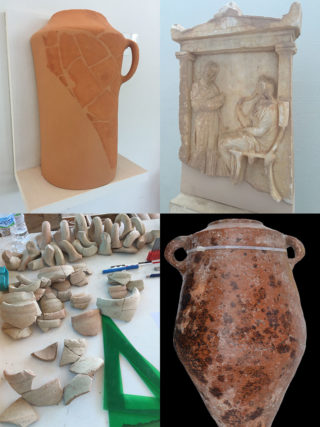About the project

The GREPURE (Grecia Púnica Redescubierta = Punic Greece Rediscovered) project is an archaeological research program that aims to gather and analyze the various material evidences documenting the contacts that linked the Phoenician and Punic spaces, in a wide geographical framework, with the heart of the ancient Hellenic space (modern Greece and western Anatolia). The period considered by this project refers to the whole of the 1st millennium BC, a period which corresponds approximately to the early and final moments of Phoenician and Punic history as an independent cultural and political group.
The GREPURE research project is funded by the BBVA Foundation, a non-profit foundation linked to the BBVA company, in collaboration with the Spanish Society for Classical Studies, a Spanish public research organization. This partnership allows the GREPURE project to benefit from the financial support of a generous sponsor, while guaranteeing the quality and objectivity of the scientific output.
In order to rediscover the Phoenician and Punic contacts with Greece, the GREPURE project aims to overcome an old vision of intercultural relations between the different shores of the Mediterranean. In fact, this research program aims to move away from the traditional view that considers there was a deep division between the eastern and western Phoenician spaces, on the one hand, and the territories occupied by the Hellenic populations around the Aegean Sea, on the other. It is true that the city-states of Ancient Greece opposed on numerous occasions to the communities belonging to the Phoenician and Punic culture. Various episodes of war and military confrontations stand witness to these oppositions and clashes, but ancient sources have transmitted to us a somewhat distorted, if not truly exaggerated, vision of most of these events.
In fact, despite the numerous conflicts between both shores of the pre-Roman Mediterranean, the populations of these two shores did not live in closed spaces and interactions between Phoenicians and Greeks were not only of a bellicose nature. Therefore, it would be a mistake to think that the long history shared by Phoenicians, Punics and Greeks was only the subject of a long uninterrupted conflict, similar to an all-out war that would have lasted hundreds of years. Similarly, it is wrong to consider Greek and Phoenician cities as culturally and politically homogeneous blocs, an observation that is even more aberrant if one considers the geopolitical reality of the ancient world: a reality made up of a multitude of communities and civic entities, in more or less open opposition, which did not hesitate to wage war with each other according to their respective interests. Thus, according to the situation of the moment, yesterday’s enemies could become faithful allies before they clashed again. The relationship between Carthage and Athens is a perfect example of such complex relationships: these two cities sometimes clashed, but also allied on occasions against a common enemy, such as Syracuse.



It should be noted that the Phoenician-Punic space is understood here in a broad sense, since the material we are studying is originating from locations situated both in the western Mediterranean and the eastern basin. From this point of view, we are not only led to consider the presence in Greece of objects or individuals from Lixus or Gadir, ancient Phoenician cities of the Iberian Peninsula, which we have to associate with western agglomerations, such as Utica, Carthage, Lilybaeum and Hadrumetum; but also the role played in these exchanges by the Phoenician cities in the Levant, like Tyre, Ashkelon or Sidon. In this case, it should be remembered that the cities of Lixus, Gadir and Carthage, to mention only a few, were all colonies or trading places founded by the Phoenician cities from the Levant between the end of the Bronze Age and the beginning of the Iron Age. In fact, although the ancient Phoenician “colonies” of the western Mediterranean eventually gained great autonomy and became metropolises in their own right, as was the case of Carthage, they all had a social and cultural link to the Levant and the Near East, the region from which they originated. For example, the sources inform us of the payment of tribute by the Carthaginians to the Tyrians. We also know that several cities resulting from Phoenician colonization shared a kind of Tyrian identity, so to speak. In addition to examining the extent of the Phoenician and Punic presence in Greece, the GREPURE project also aims to document the reality of these contacts between the two ends of the Mediterranean, since Greece was a possible stage in the creation of exchange networks that crossed this sea from one end to the other.
Far from the somewhat caricatured image conveyed by ancient sources and the discourses of certain Hellenic authors, a history that helped forge the idea of a “Mediterranean rift” between the Phoenician-Punic and Greco-Roman worlds, the GREPURE project aims to document the full complexity of the relations between these populations. Until now, research has mainly focused on the analysis of Greek influence on Phoenician and Punic cities, and many works have succeeded in highlighting the intensity of the exchanges in favor of the Hellenic cities. However, the reciprocity of such Greek influence in the Hellenic space is very little documented, and the state of research gives the impression that these exchanges were unidirectional and almost exclusively to the benefit of Greek cities. It is this vision, perhaps too Hellenic-centric, that the GREPURE project wishes to reconsider in the light of new archaeological and historical data.


